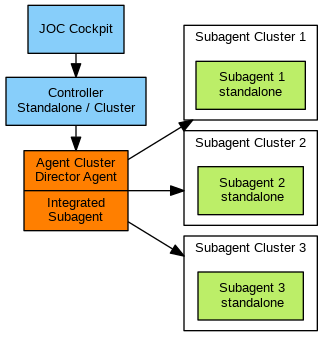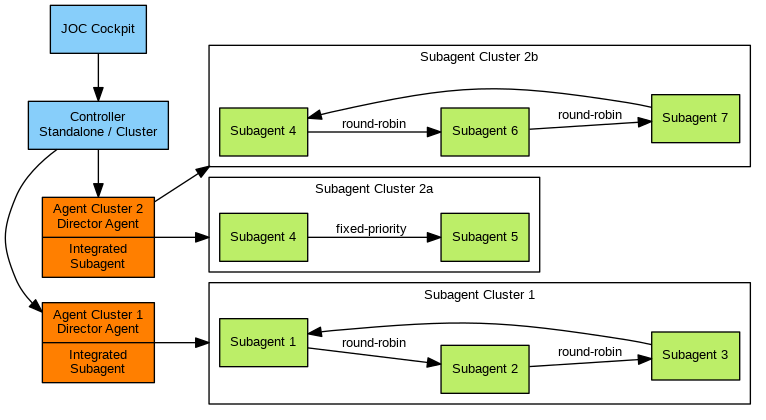Introduction
Users have a number of options for organizing their scheduling clusters.
- Agent Cluster: The operational layer of a Director Agent and a number of Subagents acting as an Agent Cluster.
- Subagent Clusters: The functional layer that groups a number of Subagents to different Subagent Clusters
This includes use of a smaller number of operational Agent Clusters with a higher number of Subagent Clusters and vice versa.
For information on how to set up Agent Clusters and Subagent Clusters see JS7 - Management of Agent Clusters
Capabilities
Subagent Clusters offer a number of capabilities:
- A Subagent can be a member of any number of Subagent Clusters.
- A Subagent Cluster can include a single Subagent and it can include any number of Subagents.
- A Subagent Cluster defines fixed-priority or round-robin scheduling mode to switch between Subagents.
Unlimited Subagents per Cluster
Any number of Subagents can be added to a cluster.
- Adding more Subagents to a round-robin cluster allows unlimited horizonal scaling.
- Some might consider it paranoid to add a larger number of Subagents to a fixed-priority cluster, however, users are free to create a chain of Subagents that can replace each other.

One Cluster per Subagent
When adding a Subagent, the JOC Cockpit can be instructed to add a Subagent Cluster which holds the single Subagent.
- This allows a job to assigned to an individual Subagent if the job is to be executed only with this Subagent.
- The name of the Subagent Cluster corresponds to the Subagent ID.

Scheduling Modes
Subagents can be added for both fixed-priority and round-robin scheduling modes:
- fixed-priority: execute jobs with the first Subagent and switch to the next Subagent only if the first Subagent becomes unavailable (active-passive cluster).
- round-robin: execute the next job on the next Subagent (active-active cluster).
The JS7 allows to use mixed scheduling modes within the same cluster.

Strategies
Director Agent as Subagent Cluster Member
Users can add a Director Agent to their Subagent Clusters:
- The Primary and Secondary Director Agents each include a Subagent that can be used to execute jobs.
- The Director Subagent can be added to any Subagent Clusters.
- Users can decide not to use the Director Agent for job execution but for orchestration of Subagents only. This will guarantee the highest level of robustness.
Agent Clusters and Subagent Clusters
Users can apply different strategies to manage operational Agent Clusters and functional Subagent Clusters.
- A single or a few Agent Clusters can be used with each holding a larger number of Subagent Clusters.
- Each Subagent Cluster selects a number of Subagents.
- The same Subagents can occur in any number of Subagent Clusters.
- The same Subagents cannot occur in more than one Agent Cluster.
- This scenario can be applied for load sharing between server nodes that act for a number of clustered applications.
- A larger number of Agent Clusters can be used that hold a single or a small number of Subagent Clusters.
- Agent Clusters are autonomous and are not related to each other.
- Each Agent Cluster is assigned an individual Director Agent that is optionally clustered.
- This scenario is preferably applied in a situation when communication between a Director Agent and Subagents should be limited to a few servers, for example, when Agent Clusters are used in separate network zones.
